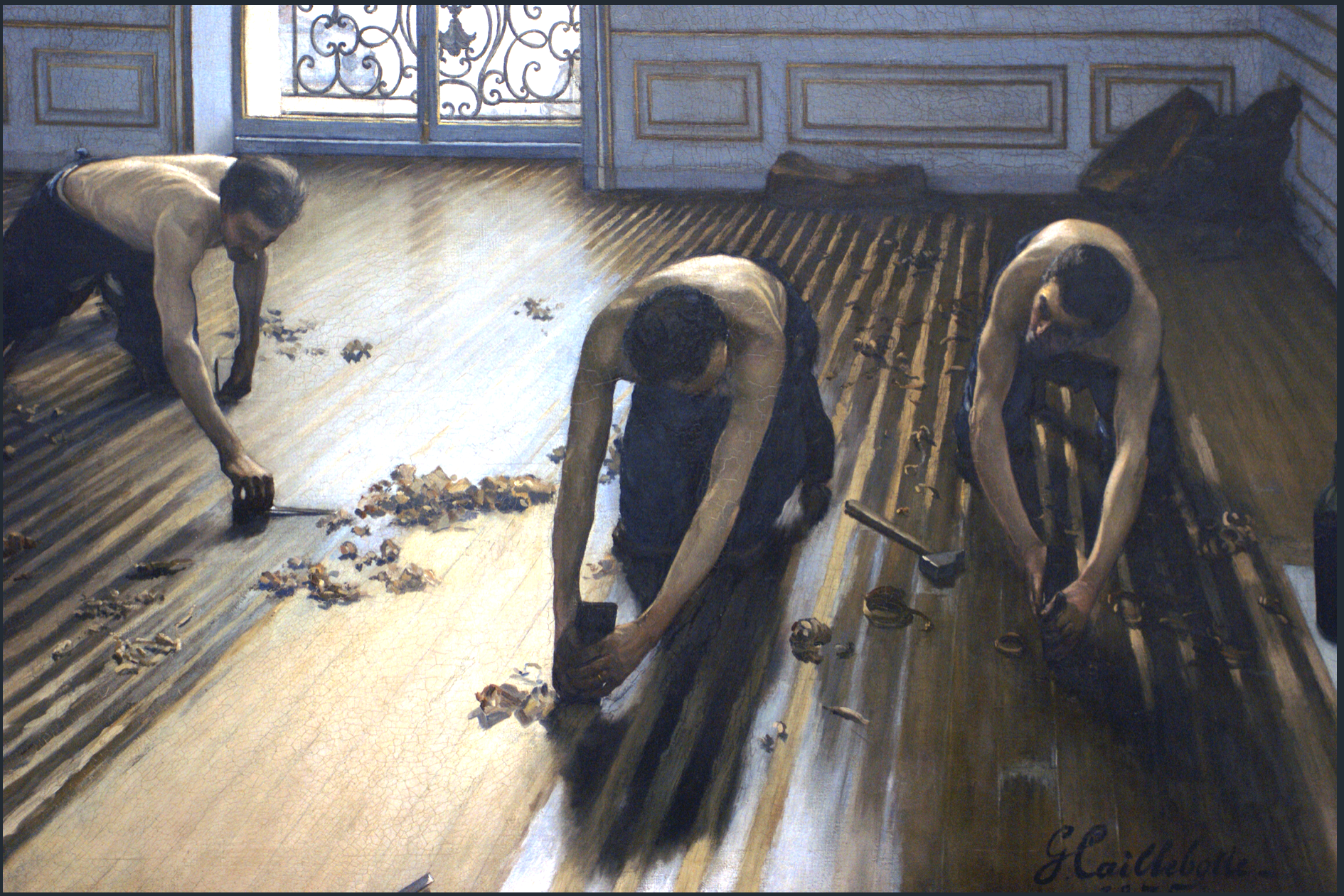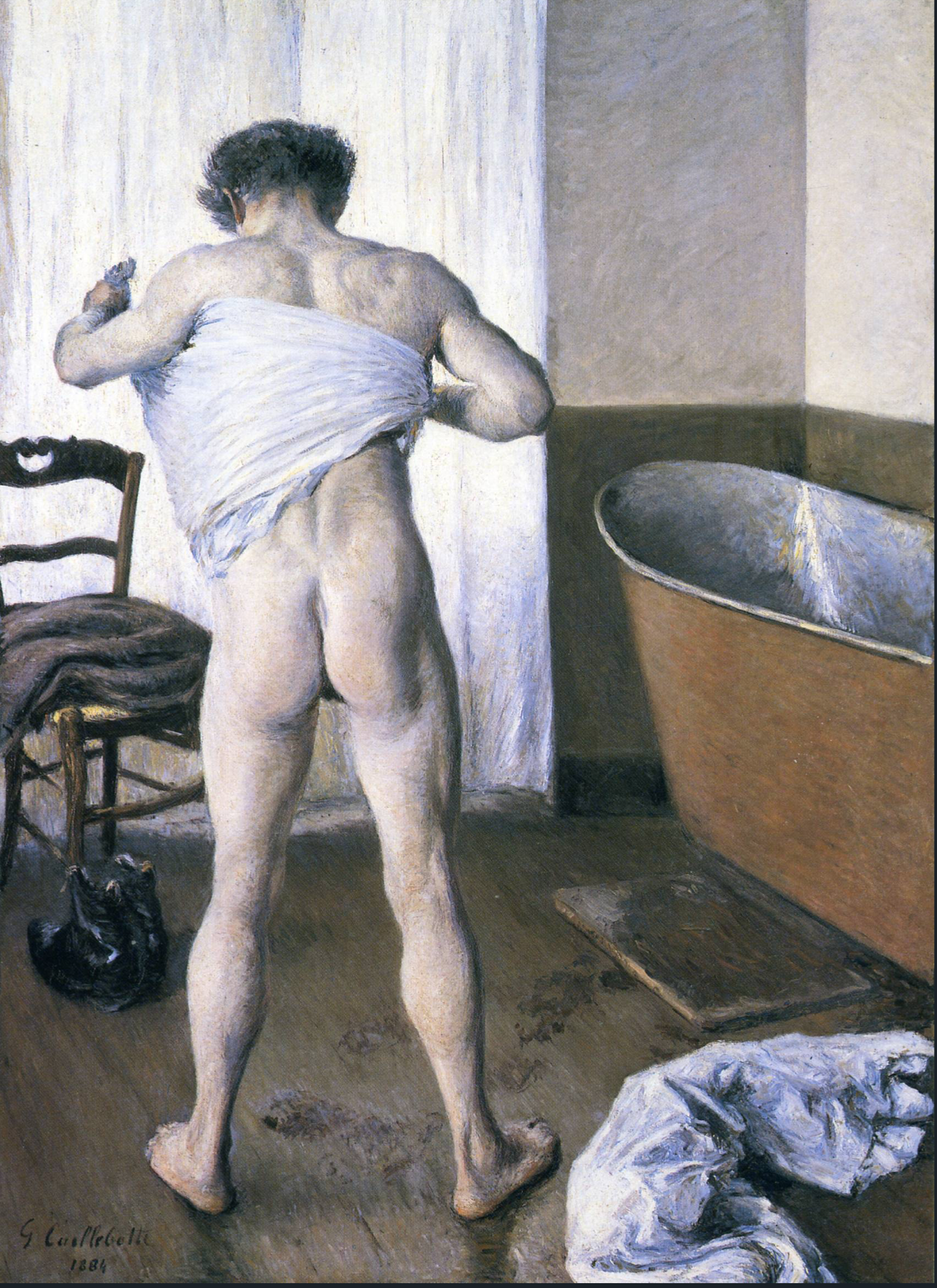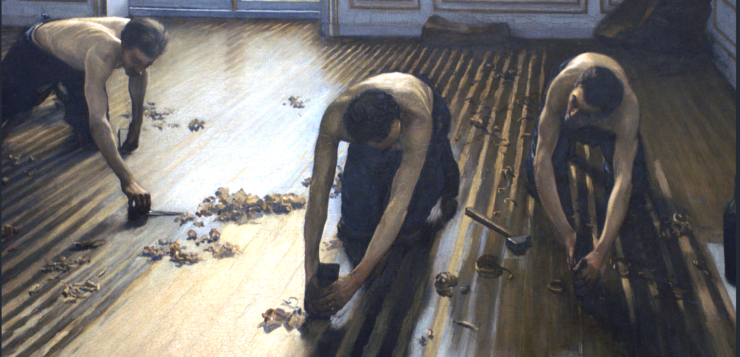PAINTER GUSTAVE CAILLEBOTTE remains the dark horse among French Impressionists, even as his contributions are increasingly being recognized by art critics and the general public. In addition to the critical attention he’s received, a quick Internet search turns up Caillebotte’s artwork reproduced on a wide variety of objects: jigsaw puzzles, coffee mugs, refrigerator magnets, books, prints, posters, shower curtains, socks, neckties, pajamas, T-shirts, backpacks, canvas totes, umbrellas, baseball caps, pillows, acrylic blocks, light switch covers, golf head covers, ceramic ornaments, business cards, throw blankets, mouse pads, wrapping paper, and more.
Commenting 25 years ago on a major traveling exhibition of Caillebotte’s work from the Musée d’Orsay in Paris, I was struck by the lengths to which the authors of the catalog essays went to avoid noticing the obvious: that many of his paintings contain homoerotic imagery that flew in the face of social and artistic norms of 1870s and ’80s France. Since then, a trickle of scholarship has acknowledged that some of his work has a decidedly “queer” aspect, such as Norma Broude’s 2002 essay, “Outing Impressionism: Homosexuality and Homosocial Bonding in the work of Caillebotte and Bazille,” in Gustave Caillebotte and the Fashioning of Identity in Impressionist Paris (Rutgers University Press).
Despite that, I think what I wrote all those years ago still largely applies. Included here are selected works by Caillebotte; you be the judge.
In 1986, The National Gallery of Art in Washington and the Fine Arts Museums of San Francisco organized The New Painting: Impressionism 1874–1886, which celebrated and re-created the eight group shows known as the Impressionist Exhibitions. Caillebotte was represented by over a dozen canvases, and it is possible to view them in their historical context. Amid the still lifes, landscapes, and interiors of the other Impressionist painters, images of women predominate. But something was different in Caillebotte’s work, which also included these other genres: it was his view of men.
In 1994, to commemorate the centennial of his death, the Musée D’Orsay in Paris and the Art Institute of Chicago organized Gustave Caillebotte: Urban Impressionist. The exhibition and its catalogue promised “new information and insight regarding one of the most engaging painters and proselytizers of the Impressionist movement.” I eagerly anticipated the exhibit in its installation at the Los Angeles County Museum of Art. The catalog essay offers a message of regret:
Since the artist is dead, no amount of documentation will ever recapture a complete reckoning of his view of the world, or understanding of him as an individual. We can compile in denser and finer-grained detail analytic accounts of the things he shared with others, from the available conventions of perspective to the character of his arrondissement; but the very things that we sense are crucial to the impact of the most personal pictures—the motivations for the choice and framing of the subject, the decisions as to what to put in and what to leave out, and so on—are the contingent elements of his private individuality on which we can only speculate without hope of confirmation.
Repeated references to Caillebotte’s distinctiveness—often framed in terms of “modernity”—seemed to dance around what was really going on in these paintings. The suggestion was never expressly put forth that there was any form of homoeroticism in evidence. Although I have read nothing in his biography to affirm that Caillebotte was in fact homosexual, it seems to me absurdly myopic not to pose this question once you see his paintings.
Art historian Emmanuel Cooper provided the justification for looking at paintings in this way, stating in The Sexual Perspective (1994):
The knowledge that an artist was or was not homosexual is not intended to “explain” their work nor is it to suggest a particular context in which to view it. It is, rather, the start of a process to look again and recover what has traditionally been omitted from the history of art using this to inform the present. What we can do most profitably is re-examine the work and lives of artists to search out from secrecy, prejudice, distortion and myth the homosexual presence and its wide significance in identifying homosexual expression.
In this essay, I am asking you to follow this procedure when looking at art, specifically that of Gustave Caillebotte—or, in other words, to follow the advice of art historian James Saslow to “trust your eyes: the gay viewer is usually far more open to suggestions of gay emotion than the art ‘experts.’”

In Caillebotte’s first major painting, The Floor-Scrapers, men are depicted laboring in a bourgeois apartment. Kneeling, their arms extended before them, their torsos bare, the men are depicted in remarkably submissive poses. Such a presentation flew in the face of traditional concepts of manhood and its artistic representation, and the canvas was rejected by the jury of the 1875 Paris Salon. Caillebotte’s motivation in refusing to observe the conventions of the time for the depiction of male workers—which would have permitted their depiction as ancient, Arabic, or other “exotic” types—is left unexplored in the catalog essays.
In discussing The Pont de L’Europe, Julia Sagraves writes that “the flâneur [loiterer]is apparently distracted by the fashionably dressed woman he has just passed, who, in turn, seems to glance suggestively toward him. Importantly, competing with this implied sexual exchange in The Pont de L’Europe however, is a social one: the flâneur appears equally if not more, distracted by the figure of the worker in whose direction he seems to stare.” Why is the male-female exchange assumed to be “sexual” and the male-male interaction “social”? From my perspective on the bridge, it is obviously just the opposite.
In the examination of The Pont de L’Europe (Variant), a class analysis is finally put forth. “Their faces hidden from view, these men appear to be anonymous figures, ‘everymen’ of late nineteenth century Paris. Their contrasting attire, however, is evidence of their class difference.” The top hats and frock coats of the two gentlemen are markedly different from the attire of the third figure. He wears the blue smock of the working class, though “his conspicuously fashionable bowler suggests his upward mobility.” In 1914, E. M. Forster finished a draft of Maurice that concluded with Maurice, a member of the middle class, overcoming social and above all sexual barriers to live happily ever after (we presume) with Alec, the gamekeeper. I see a similar dynamic here: this looks to me like a scene of men crossing class boundaries to cruise one another.
Let’s go back inside, where, the catalog essay by Gloria Groom tells us: “These interiors reveal a different gendering of spaces, where the man is absorbed into the domestic sphere and where the woman is not a mere decorative motif.” In the context of conventional representations of gender-conforming men and women, a painting like Portrait of a Man “is a decidedly uncommanding, decorative, ‘feminized’ and thus complicated portrait.” In Self-Portrait at the Easel, we see a man in his studio painting what’s billed as a “self-portrait”; and yet he is not alone in an isolated retreat, as we soon discover another man lounging on a sofa behind the artist. For this is, in the words of Anne Distel, “a room in which a friend could feel at ease”—or a lover, I feel compelled to add.
Finally, Caillebotte’s most overt break with contemporary iconography was his depiction of male nudes in such paintings as Man at His Bath. In the words of Gloria Groom:
Caillebotte’s challenge to the male gaze is all the more flagrant in the large picture of the standing male nude drying his back. In these paintings, he focused on what is either a dressing room or bathroom, both of which were traditionally reserved for feminine activities of washing, dressing, and putting on make-up. But these nude men are not just toweling off after a bath. They have taken a bath that Caillebotte has witnessed, or staged, to look as if he had done so, and are now being observed by the male onlooker. If the female body was the territory of modernity as a sign of male sexuality, what is one to make of his naked males which break iconographically and ideologically from the norms of nineteenth century art and literature. Who were these men? Were they friends of the artists or part of his household staff?
Who, indeed? But either way, whether friends or staff, the nature of the relationship between artist and model seems to go beyond the customary level of familiarity.

My aim here is not one of adjudication. Far be it from me to determine whether or not Gustave Caillebotte was gay (whatever that means for his era), but I do wonder why art historians are failing to ask questions which could illuminate aspects of his work that distinguish it from that of his contemporaries. Indeed, the issue is repeatedly circumvented: “Caillebotte adhered to the patrician attributes of a code of family honor, and the cult of male friendship. … Caillebotte’s images suggest that he was uncomfortable with his class as his social identity.” Perhaps that’s because another kind of identity was getting in the way. His work is seen to offer “no relaxation of defenses even within one’s private space,” but the possible reason for this unease, this “pervasive melancholy,” is never explored.
Jim Van Buskirk was the founding Program Manager of the James C. Hormel LGBTQIA Center at the San Francisco Public Library (1992-2007). This essay, including a dozen images, was originally published in 1998 in the now defunct Queer Arts Resource.







Discussion1 Comment
The three-way dynamic in Le Pont de L’Europe becomes even more interesting when you see an earlier, rough version of the painting, in which the female figure strides a bit ahead of the gentleman, essentially blocking his view of the other man; it seems significant that Caillebotte in the final composition moves her back, bringing the two male figures to the fore and into alignment. You can see the both version’s at the painting’s wikimedia commons page: https://en.wikipedia.org/wiki/File:Caillebotte-PontdeL%27Europe-Geneva.jpg